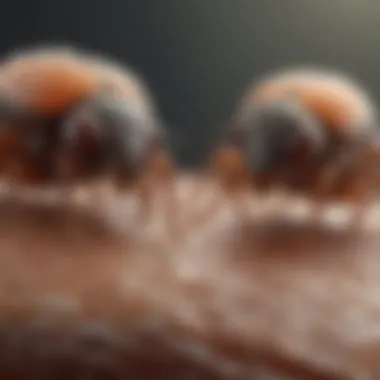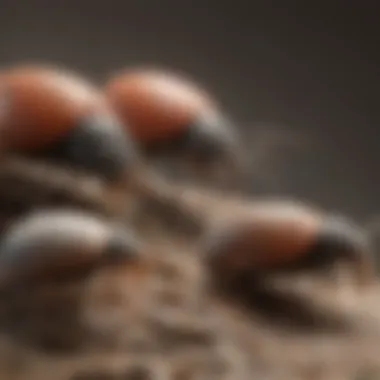Mites vs. Lice: Key Differences and Pet Implications


Intro
Mites and lice are two types of parasites that commonly affect pets. Many pet owners may struggle to tell them apart. Understanding these parasites is vital. Mites and lice not only cause discomfort but can also lead to serious health issues.
Parasites can impact the health of pets significantly. This article aims to clarify the differences between mites and lice. We will look at their biology, behavior, symptoms, and treatment options. This knowledge will help pet owners care for their animals more effectively.
Grooming Techniques
Preventing infestations with proper grooming is essential. Regular grooming can keep pets healthy and comfortable.
Basic Grooming Tools
Having the right tools makes grooming more effective. Here are some basic tools that you should consider:
- Flea comb: A fine-toothed comb helps remove lice and mites from fur.
- Brush: A good brush is important for keeping coats tangle-free.
- Scissors: These can help neatly trim fur around sensitive areas.
- Shampoo: Use a medicated shampoo to treat infestations.
Step-by-Step Grooming Guides
- Check for signs of infestation. Look for excessive scratching or hair loss.
- Bathe the pet with medicated shampoo, focusing on areas most likely to harbor parasites. Rinse thoroughly.
- Comb through the coat with a flea comb after drying for any remaining pests.
- Brush the coat to remove loose fur and dirt. This promotes healthier skin and coat.
- Inspect the ears and skin for any unusual changes or signs of irritation.
Breed-Specific Grooming Needs
Different breeds may have different grooming needs:
- Long-haired breeds require more regular grooming to prevent matting.
- Short-haired breeds often need less grooming but still require regular checks.
- Dogs with sensitive skin may need specific products that are gentler on their skin.
Health and Wellness
Keeping pets healthy goes beyond grooming. Nutrition, routine veterinary visits, and awareness of health issues are crucial.
Nutrition and Diet Tips
A balanced diet supports the immune system. Make sure your pet gets:
- High-quality protein
- Omega fatty acids for skin health
- Sufficient vitamins and minerals
Common Health Issues and Solutions
Infestations can lead to other health issues. Some common problems include:
- Skin infections due to scratching
- Secondary infections, which can be more serious
Importance of Regular Check-Ups
Regular veterinary visits help catch problems early. Vets can provide tailored advice and monitor your pet's health.
Training and Behavior
Understanding and addressing behavioral issues can also support pet health. Training contributes to a well-behaved, balanced pet.
Basic Training Commands
Teaching commands is fundamental. Start with:
- Sit
- Stay
- Come
These commands promote safety in various situations.
Understanding Common Behavioral Issues
Some pets may show signs of distress. Watch for:
- Excessive digging or scratching
- Aggressive behavior towards others
These can indicate pain or discomfort caused by parasites.
Techniques for Effective Training
Use positive reinforcement to motivate learning. Be consistent, and remember to keep training sessions short but frequent.
Product Reviews
Knowledge about effective products is critical for pet care. Here’s a summary of recommended items.
Comparison of Grooming Tools


When selecting tools, consider effectiveness and comfort. Tools like the Hertzko Self Cleaning Slicker Brush or the Safari Flea Comb are well-rated by pet owners.
Best Pet Products for Health
Products like Frontline Plus or Advantage II offer effective protection against flea and tick infestations. They are reliable and widely used.
Review of Training Aids
Tools such as clickers or treat dispensers can enhance training efforts. They help reinforce positive behavior.
Community Insights
Seeking advice and experiences from others can be beneficial. Community resources often provide practical tips.
User-Submitted Tips and Tricks
Look for shared experiences on platforms like Reddit. Users often post insights that have worked for their own pets.
Real-Life Grooming Experiences
Community forums can share stories about successful grooming practices. Real cases provide helpful lessons.
Expert Guest Contributions
Occasionally, experts provide insights through guest posts. They can share advanced techniques that may benefit pet owners.
Remember, a proactive approach in pet care minimizes the risks of infestations. Knowing the difference between mites and lice equips pet owners to handle issues more effectively.
Overview of Parasites in Pets
Parasites, particularly mites and lice, pose significant challenges in pet care. They impact the health and well-being of pets, making a clear understanding of these organisms essential for pet owners. Each parasite comes with its own unique set of characteristics, behaviors, and implications for infestations. Recognizing these differences can enhance the ability to manage and prevent such issues effectively.
Defining Parasites
Parasites are living organisms that rely on a host for survival. They feed on the host's resources, which can lead to health problems. There are different categories of parasites, including ectoparasites and endoparasites. Mites and lice belong to the ectoparasite group, as they live on the surface of the host's body. These organisms can exhibit a variety of life cycles and behaviors that affect pets differently.
Importance of Understanding Parasite Types
Understanding the types of parasites that may infect pets has several benefits. First, it allows for early detection of infestations. By knowing what signs to look for, pet owners can address issues before they escalate. Furthermore, appropriate treatment options vary significantly between mite and lice infestations. Misidentifying the type of parasite can lead to ineffective treatments, worsening the pet's condition.
Additionally, comprehending the life cycles and transmission methods of these parasites can aid in more effective prevention strategies. For instance, some mites may thrive in certain environmental conditions. Understanding these factors can guide pet owners to create a healthier habitat for their pets.
In summary, an overview of parasites in pets is crucial. It equips pet owners with the knowledge they need to protect their pets from harmful infestations.
Mites: An In-Depth Analysis
Mites, though often overlooked, play a significant role in the lives of our pets. Understanding mites is essential for pet owners, as their presence can lead to serious health implications. This section will help in exploring various facets of mites, addressing biological classifications, common types, life cycles, and more. By identifying how mites impact animal health, pet owners can implement effective prevention and treatment measures.
Biology and Classification of Mites
Mites belong to the class Arachnida, which groups them closely with spiders and ticks. Their biology reveals a diverse spectrum of species, with some being parasitic while others are free-living. Mites can be as small as 0.1 mm, making them difficult to detect without proper examination.
The primary classifications include:
- Acari: This is the largest order that includes both mites and ticks.
- Prostigmata: Often found in moist habitats. Some species are parasitic.
- Mesostigmata: Characterized by their distinctive acariform body structure, many of these are predatory.
Common Types of Mites Affecting Pets
There are several types of mites that most commonly affect pets. Here are a few:
- Demodex Mites: Typically found on the skin of mammals, these mites usually do not cause problems unless the immune system is compromised.
- Sarcoptes Mites: Known to cause scabies, which leads to intense itching and skin infections.
- Otodectes Mites: These are common in cats and dogs, leading to ear infections.
Each type has specific characteristics that can greatly impact an animal's health.
Life Cycle of Mites
The life cycle of mites consists of several stages: egg, larva, nymph, and adult. Understanding these stages helps in managing infestations. Mites typically reproduce quickly, with some species laying hundreds of eggs within a few days. This rapid reproduction can lead to severe infestations if not addressed promptly.
Stages of Mite Life Cycle:
- Egg: Laid on or near the host.
- Larva: The first stage, which usually leaves the egg.
- Nymph: Following the larval stage, this immature stage molts several times.
- Adult: The final stage; capable of reproduction.
Behavioral Characteristics of Mites
Mites display diverse behaviors depending on their environmental demands and hosts. Parasitic mites often seek out specific areas on the host to thrive, utilizing their mouthparts to feed on skin or bodily fluids. They can be found in fur or skin folds, where warmth and humidity are prevalent.
Signs of Mite Infestation in Pets


Recognizing signs of mite infestations is crucial for pet owners. Some common indicators include:
- Excessive scratching or biting at the skin.
- Red, inflamed skin or patches of hair loss.
- Ear discharge or foul odor coming from the ears.
Important: Early detection can help avoid complications associated with chronic infestations.
Health Implications of Mite Infestations
Mite infestations can lead to various health issues, ranging from localized infections to systemic problems. For instance, intense itching may result in secondary bacterial infections due to constant scratching. In severe cases, mites can cause significant hair loss and skin damage, promoting a suitable environment for other parasites or infections.
Treatment Options for Mite Infestations
Treating mite infestations generally involves both topical and systemic treatments. Effective options include:
- Topical treatments: Creams and dips specifically designed to kill mites.
- Oral medications: Pets may require systemic treatment for thorough eradication.
- Environmental control: Cleaning bedding and impacted areas to reduce reinfestation.
Pet owners should consult a veterinarian for accurate diagnosis and tailored treatment plans. Understanding mites and their management improves overall pet health and well-being.
Lice: A Comprehensive Overview
Lice are a significant concern for pet owners due to their direct impact on the health and comfort of pets. This section provides a detailed examination of lice, covering their biology, common types, life cycle, behavioral traits, and signs of infestation. Recognizing lice infestations early is critical. Pet owners should understand the health implications and available treatments to ensure the well-being of their animals. Each type of lice affects pets in unique ways, making it important to differentiate between them.
Biology and Classification of Lice
Lice belong to the order Phthiraptera. They are wingless ectoparasitic insects that are highly specialized to live on their hosts. These parasites are classified into two main categories: chewing lice and sucking lice. Chewing lice feed on skin debris, while sucking lice consume blood from their hosts. This distinguishes them not only in feeding behavior but also in their health implications for pets. Lice typically are small, with body sizes ranging from 1 to 2 mm. Their flat bodies allow them to cling tightly to the fur or feathers of animals.
Common Types of Lice Found in Pets
The common types of lice found in pets include:
- Felicola subrostratus: This is a chewing louse specifically found in cats. It feeds on skin flakes and can cause irritation.
- Trichodectes canis: A chewing louse often seen in dogs, associated with skin irritations and mild discomfort.
- Linognathus setosus: This is a sucking louse found in dogs, feeding on blood and can lead to more serious health issues.
- Htmlignathus: This type is found in various animal species, including birds, and can have significant implications for both wild and domesticated creatures.
Understanding these types can help owners identify the appropriate course of action if their pets are affected.
Life Cycle of Lice
Lice have a simple life cycle, which consists of three stages: egg (nit), nymph, and adult. The adult female louse lays eggs, usually attached to the hair or feathers of the host. These nits hatch into nymphs after a few days. Nymphs resemble adult lice, though smaller. The nymphs grow into adults typically within 1-2 weeks. Adult lice can reproduce rapidly, leading to significant infestations in a matter of weeks. Knowing this life cycle aids in understanding the urgency in addressing lice infestations.
Behavioral Characteristics of Lice
Lice exhibit specific behaviors that reflect their adaptations. They spend their entire life cycle on their host and are often found in areas where the animal's fur is thick. Adult lice can move quickly, but they do not jump or fly. They tend to hide at the base of hair shafts or in areas where the skin is warm. Lice are generally not highly mobile away from their host, making them highly dependent on their chosen animals for survival.
Signs of Lice Infestation in Pets
Identifying lice infestations may involve observing certain signs:
- Excessive scratching or grooming behavior
- Visible nits or lice in the fur or on the skin
- Red or irritated skin
- Hair loss or thinning fur
- Behavioral discomfort, such as restlessness
Pet owners should regularly check their animals for these signs, especially if they come into contact with other pets. Early detection can simplify treatment options.
Health Risks Associated with Lice Infestations
Lice infestations can lead to various health issues for pets, including:
- Skin infections: Open wounds from scratching can become infected.
- Anemia: Sucking lice can lead to blood loss, resulting in anemia, particularly in pets with heavy infestations.
- Dermatitis: Allergic reactions to lice saliva can cause skin irritations.
- Discomfort and stress: Pets may show signs of stress or discomfort due to constant irritation from lice.
Understanding these risks emphasizes the need for prompt action when lice are discovered on pets.
Treatment Strategies for Lice Infestations
Treating lice infestations involves a multifaceted approach:
- Topical insecticides: Products like fipronil or pyrethrins are often used.
- Oral medications: These can help eliminate infestations from the bloodstream.
- Environmental cleaning: Regular washing of bedding and grooming tools is essential to prevent re-infestation.
- Regular veterinary consultations: A veterinarian can provide tailored treatment plans based on the type of lice and pet condition.
Effective treatment and prevention strategies are key. They not only address the current infestation but also help to ensure that pets remain free from lice in the future.
Comparative Analysis: Mites vs Lice
Understanding the comparative analysis between mites and lice is crucial for pet owners. Both parasites can impact the health of pets, creating discomfort and leading to more serious health issues if not addressed. This section highlights the biological and behavioral differences, their respective health impacts, and how they transmit among host animals.
Biological Differences
Mites and lice belong to different biological classifications, which influences their anatomy and life cycle. Mites are arachnids, closely related to spiders and ticks, with a life cycle that includes egg, larval, nymph, and adult stages. In contrast, lice are classified as insects, undergoing a simpler life cycle of egg (nit), nymph, and adult.
- Size: Mites are generally smaller, ranging from 0.2 to 1 mm. Lice are larger, about 1 to 2 mm in length.
- Body Structure: Mites have a more rounded body, while lice possess a flattened body suited for gripping fur or feathers.


These biological differences influence their methods of feeding and survival. Mites often burrow into the skin, whereas lice feed on blood or skin debris on the surface.
Behavioral Differences
The behaviors demonstrated by mites and lice vary significantly. Mites tend to be secretive and can live within the skin of the host. This behavior complicates detection and treatment. Lice, on the other hand, are much more visible as they crawl on the surface, making them easier to spot during grooming.
- Movement: Mites are often slow movers, while lice are agile and can quickly scurry across the skin.
- Feeding Habits: Mites can be scavengers or parasites, often causing more severe reactions in the host when feeding. Lice engage in direct blood feeding, leading to anemia and irritation in pets.
This behavior plays a significant role in how pet owners manage and identify infestations.
Impact on Host Health
Both mites and lice can cause various health problems for pets, but the severity can differ greatly.
- Mites: Infestations may lead to conditions such as mange or dermatitis. These conditions can cause intense itching and skin inflammation, impacting the pet's overall well-being.
- Lice: These parasites can cause itching and irritation but may also lead to secondary bacterial infections from scratching. In severe cases, lice can cause anemia, especially in young or weak pets.
Understanding these health impacts can help owners to act promptly in seeking veterinary assistance when necessary.
Methods of Transmission
The transmission methods of mites and lice also have important implications for pet care.
- Mites: They can spread through direct contact with infected animals or contaminated bedding and grooming tools. Certain types of mites may also be transmitted by the environment, particularly the sarcoptic mites causing mange.
- Lice: These are highly contagious within species, often spread during close contact. Lice do not usually survive off their host for long; thus, transmission commonly occurs through grooming, sharing bedding, or direct physical contact.
Awareness of these transmission methods empowers pet owners to implement preventive strategies, reducing risks of infestation.
A clear understanding of how mites and lice differ is essential for effective management and care. Their impacts can range from mere irritation to serious health complications, emphasizing the need for diligence in monitoring and prevention.
Preventative Measures for Pet Owners
Preventing infestations in pets is essential for their overall health and wellbeing. Both mites and lice can cause significant discomfort and health issues for animals. Understanding preventative measures can help pet owners effectively safeguard their pets from these parasites. Taking proactive steps can reduce the chances of infestations and create a healthier environment for pets.
Regular Grooming Practices
Regular grooming is one of the most effective ways to prevent mite and lice infestations. Grooming not only keeps pets clean but also allows owners to check for early signs of parasites. Brushing the fur can remove loose hairs and debris that may harbor pests. Pet owners should:
- Choose the right grooming tools: A comb or brush suitable for the pet's fur type can help remove parasites and dirt.
- Establish a routine: Regular grooming sessions, ideally once a week, can help maintain healthy skin and fur.
- Inspect for signs: During grooming, look for any unusual itching or irritation, which could indicate an infestation.
Regular grooming fosters a bond between owner and pet, creating a calm environment during these activities. This practice significantly contributes to overall pet health.
Environmental Management
Environmental management is crucial in minimizing the risk of mite and lice infestations. These parasites can thrive in specific conditions. By managing the environment, pet owners can reduce potential breeding grounds. Here are some strategies:
- Keep living areas clean: Regularly vacuum carpets, rugs, and furniture where pets spend time to remove allergens and potential pests.
- Wash pet bedding: Clean pet bedding frequently using hot water to eliminate any eggs or larvae.
- Limit exposure to infested areas: Be cautious when visiting places with high animal traffic, such as parks or grooming facilities. These environments can host a range of parasites.
Managing the pet's surrounding environment can significantly decrease the chances of encountering parasitic infections.
Monitoring for Early Signs of Infestation
Early detection of mite or lice infestations is key to effective treatment. Pet owners should be vigilant and monitor their pets regularly. Here are ways to identify early signs:
- Observe behavior: Unusual scratching or biting at certain areas can indicate discomfort. This can escalate if left unchecked.
- Check fur and skin: Look for any visible signs such as small white or grey insects, or skin irritation.
- Note changes in health: Sudden weight loss, lethargy, or changes in appetite can also be signs of a parasitic problem.
Regularly identified signs can lead to quicker treatment and minimize potential health issues.
By implementing these preventative measures, pet owners can ensure a healthier life for their pets and decrease the risk of infestations. Combining grooming, environmental management, and monitoring habits creates a robust defense against mites and lice.
Finale and Recommendations
Addressing parasites like mites and lice is crucial for the health and well-being of pets. This section emphasizes the importance of understanding the topic in detail. Not only does it allow pet owners to properly identify the type of infestation affecting their animals, but it also enables them to take effective action. Each parasite has unique characteristics, behaviors, and treatment options that may vary.
It's essential for pet owners to be aware of the signs of infestations to respond promptly. Early detection can prevent severe health implications, including skin infections or, in extreme cases, systemic health problems. Understanding the biology and life cycle of these pests helps owners manage their environment better and reduces the likelihood of reinfestation.
To combat these parasites effectively, the following considerations should be taken into account:
- Always consult a veterinarian for accurate diagnosis and treatment options.
- Maintain regular grooming routines to check for signs of these pests.
- Keep the pet's living environment clean and make necessary adjustments.
"Knowledge is power in managing pet health. The more informed the owner is, the more successfully they can mitigate risks associated with mites and lice."
Recap of Key Differences
In summary, recognizing the key differences between mites and lice is fundamental for effective pet care. Mites, typically small and more varied in type, can cause a range of conditions from mange to ear infections. In contrast, lice are species-specific parasites that often lead to irritation and discomfort. Understanding their distinct life cycles, signs of infestation, and health consequences will help owners make informed decisions about preventative measures and interventions.
Key Differences:
- Life Cycle: Mites have more complex life cycles involving various stages, while lice tend to have a more straightforward development process.
- Transmission: Mites can spread through various means, including direct contact or environmental exposure. Lice are generally transferred through direct contact with infested animals.
- Health Risks: Mites can lead to more severe health issues, whereas lice usually cause discomfort but can be managed more easily.
Final Thoughts on Mite and Lice Management
Managing mites and lice requires a proactive approach. Regular grooming, environmental management, and monitoring for early signs of infestation are vital strategies. Pet owners should not only focus on treatment after detecting a problem but should also consider implementing preventative measures as standard practice.
Effective communication with a veterinarian aids in creating a tailored plan that suits the specific needs of each pet. Also, using quality products designed to combat these parasites can enhance the effectiveness of treatment. Overall, informed and diligent management ensures the long-term health of pets and fosters a happier living environment. Taking these steps will empower pet owners to protect their furry companions more effectively.







